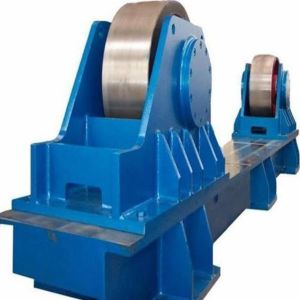
100MT Conventional Welding Rotator
1,260,000 - 1,280,000 Per Set
1 Set (MOQ)
Welding rotators are an essential and versatile piece of positioning equipment in any fabrication workshop. INNOVIC offers a wide range of welding rotators, each designed for specific applications. These machines include the following types: Conventional Rotators Conventional rotators consist of two sets of adjustable rollers. The rollers can be adjusted manually or through a lead-screw and ratchet mechanism to accommodate different vessel diameters. This allows for smooth transitions between varying sizes without much hassle. Conventional Rotators: Built for Heavy-Duty Applications INNOVIC’s conventional rotators are engineered with capacities ranging from 1 tonne to 2000 tonnes. The frame features a robust, fabricated design that is precision-machined both on the top and underneath to ensure perfect alignment. Both the drive and idler frames come equipped with durable, fabricated and machined wheel brackets that securely support the axles and bearings of the rollers. Depending on the capacity, the rotators are fitted with either all-polyurethane wheels with overload protection or all-steel wheels to handle different load requirements. The chassis, or base structure, of the rotator is carefully designed and fabricated to support the weight of the vessel or job, with an additional margin for shock loads. This is crucial for preventing any frame distortion that could lead to misalignment of the rollers. The drive section experiences the highest strain during the loading process, as it is difficult for a crane operator to perfectly position the vessel so it contacts both roller sets simultaneously. If the workpiece contacts one set of rollers before the others, the initial roller experiences a full shock load, which places significant force on the drive system. To counter this, INNOVIC rotators are designed with a substantial overload margin to absorb these shock loads effectively, ensuring safe and smooth operation.

conventional rotator
Get Price Quote
Conventional Rotators are built in capacities from 1T to 2000 tonnes. The frame is of robust fabricated construction and is machinened on the top and underneath to ensure perfect alignment. Both the drive and the idler frames are provided with robust fabricated and machined wheel brackets which support the axles and bearings of the rollers. According to capacity the Rotators are provided with all rubber tyres, or Polyurethane tyres and separate all steel overload wheels, or can be of course be supplied with cast steel wheels. The Rotator base fabrication, or chassis, is designed and fabricated to carry the weight of the vessel / Job and incorporates a contingency for shock loading. It is important that the design eliminates any distortion which can lead to misalignment of the rollers. The drive section comes under the biggest strain when the vessel /Job is being loaded. It is physically impossible for a crane operator to position the vessel so that it contacts with both sets of rollers at the same time. If the work-piece one roller before being supported on all the rollers, the first roller will receive a full shock load which puts a considerable force on to the drive. We have endeavored to incorporate a good overload margin to absorb this shock load.
Best Deals from Conventional Rotator

Conventional Rotators
Get Price Quote
Conventional Rotators are built in capacities from 1T To 2000 Tonnes. The frame is of robust fabricated construction and is machinened on the top and underneath to ensure perfect alignment. Both the drive and the idler frames are provided with robust fabricated and machined wheel brackets which support the axles and bearings of the rollers. According to capacity the Rotators are provided with all Polyurethane wheels with overload disc and all steel wheels. The Rotator base fabrication, or chassis, is designed and fabricated to carry the weight of the vessel / Job and incorporates a contingency for shock loading. It is important that the design eliminates any distortion which can lead to misalignment of the rollers. The drive section comes under the biggest strain when the vessel /Job is being loaded. It is physically impossible for a crane operator to position the vessel so that it contacts with both sets of rollers at the same time. If the work-piece one roller before being supported on all the rollers, the first roller will receive a full shock load which puts a considerable force on to the drive. We have endeavored to incorporate a good overload margin to absorb this shock load.

welding conventional rotators
Get Price Quote
welding conventional rotators, Welding Equipment, Welding Positioners